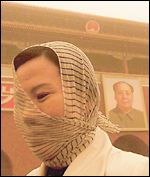The Christian Science Monitor: Beijing fends off monsters on its steppes (Photo)

TEMPEST: A woman covers her head Wednesday as a dust storm fills Beijing with amber-colored wind. GUANG NIU/REUTERS
March 22, 2002
BEIJING -- It is born in the Gobi desert. Each spring it sucks up fine sands, growing more malevolent as it inhales dust over the bald steppes of Inner Mongolia and slouches toward Beijing. Who says monsters don't exist?
We speak of Beijing's spring dust storms -- fengchenbao, or "wind-dust-tempest." Part natural, part man-made, an environmental troublemaker, the tempest fills the sky from the west like a special-effects sequence from the recent Hollywood thriller "The Mummy Returns."
This year's first dusty beast made an early showing last week, sending fine yellow dust through mesh screens and under doors, violating the microscopic cracks of civilization. It settled in file drawers, between pages, past the face scarves of cyclers. It crept into the narrows between spice jars, tracked wantonly from room to room, and settled into toothbrush trays.
Last year, 18 monster storms assaulted Beijing during the first six months of 2001. The year before, one storm killed several construction workers and the dust cleanup took days.
Fortifying the city
Now, using the politically potent lever of Beijing's 2008 Olympic Games, Chinese officials are pledging to mollify the monster by various means. The "Around Beijing Sand Source Controlling Project" -- that is, a massive tree planting project -- earmarks $120 million to plant a series of "green belt" forests around the city.
Some retired Chinese have, for years, planted their small orchards and hundreds of trees, on a freelance basis, in a small attempt to harness the beast. But it's not enough, says Jia Baoquan of the China Forestry Research Institute. "A network of green belts is an important and effective measure to keep the sand and dust ... from being blown into the city. But it is not enough just building a defense. We should find and deal with the source."
Just what the wind tempest is -- its frequency and identity -- is debated. Studies suggest the number of full-blown, if you will, "sandstorms" are in decline. But the number of so-called "sand-flying days" are still high -- 20 to 40 a year, depending on conditions such as drought. Last year there were 32.
Most scientists agree that little can be done about the Gobi winds that kick up when colder desert air mixes with warmer air. "Strong winds can carry dust particles 1,600 miles or more," says Yang Weixi of the China Forestry Administration.
But the most alarming problem is man-made -- the deforestation of grasslands. Years of heavy farming and animal grazing on the plains of north China have stripped them of trees and other foliage that keep soil protected, packed, and intact. Now the bare land is a dust bowl that partners with the moving winds. Grasslands are disappearing at the rate of 1,000 square miles a year, according to the China-Japan Environmental Protection Bureau.
Environmentalists worry that ongoing deforestation could turn Tibet and other lands to the west into an adjunct of the Gobi, and that if unchecked, the dust-monster winds could one day reach as far south as Shanghai.
The most ambitious project is a $6 billion pledge to create a "green wall" to block the monster from invading Beijing, just as the Great Wall served to stop barbarian hordes.
A series of forests and orchards stretching over some 250,000 square miles are to be created between Beijing and Inner Mongolia between now and 2008. Yet many scientists say a 2008 end-point for the dust is unrealistic.
Last August, China and Mongolia reached an agreement to improve river beds that help promote irrigation to dusty areas, and to plant forests.
Early warning system
Most Beijingers, however, are resigned to enduring the dust. Last weekend was an example.
Owing to the mild winter and overheated buildings, windows were left open even as the sky turned the color of a used floor mop. Rivulets of dust formed, and what was to be a zhomuo yukuai, or happy weekend, became a Sunday toil for those who spent it cleaning.
Adding man-made insult to man-made injury, winds in recent years have whipped up tons of dust from Beijing's countless large-scale construction sites.
The sites, sprawling from downtown to the farthest suburb, use a lot of light sand, and the work unpacks old soil. Beijing's environmental protection bureau said this week that building sites that don't cover their sand piles and excavations will be fined $150 to $12,000.
Supposedly, China is developing "sandstorm early-warning stations" in western provinces such as Gansu, Shanxi, and Hubei.
Like hurricane warning bureaus along the US East Coast, these will provide a warning of new fengchenbao as they develop.
Maybe they are already at work: Beijingers were warned two days early of the fengchenbao that hit on Wednesday.
http://www.csmonitor.com/2002/0322/p07s01-woap.html